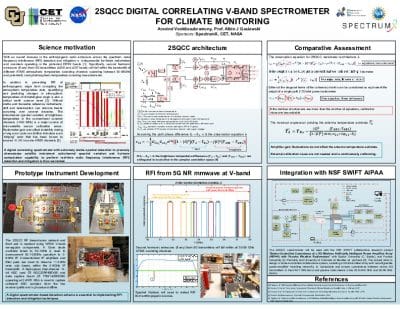Authors
Aravind Venkitasubramony, Prof.Albin J Gasiewski
Abstract
With an overall increase in anthropogenic radio emissions across the spectrum, radio frequency interference (RFI) detection and mitigation is indispensable for future radiometers and sounders operating in the protected EESS bands. Specifically, second harmonic emissions (if any) from 5G transmitters (n258 and n257 bands) will fall within the bandwidth of different ATMS atmospheric temperature sounding channels operating between 50-58GHz and potentially corrupt atmospheric temperature sounding measurements.
In addition to preventing RFI of anthropogenic origin from corrupting the atmospheric temperature data, quantifying and predicting changes in atmospheric temperature of climatological origin is also a critical earth science need. Without stable and traceable reference instruments, drift and deterioration can obscure trends occurring over several decades. The intrachannel spectral variation of brightness temperature in the conventional sounder channels (~400 MHz) is a major source of inter-satellite sensor calibration errors. Radiometer gain and offset instability during a long scan cycle can further introduce scan “striping” errors that have been known to exceed ~0.3 K in some ATMS channels. A digital correlating spectrometer with extremely stable spectral detection to precisely characterize satellite instrument sub-channel spectral variation and kurtosis computation capability to perform real-time radio frequency interference (RFI) detection and mitigation is thus warranted.

